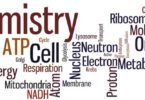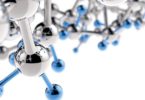The laws of chemical combinations (Chemistry) Multiple choice questions and answers:
Which of the following pairs of substances illustrates the law of multiple proportions?
(a) CO and CO2
(b) H2O and D2O
(c) NaCl and NaBr
(d) MgO and Mg(OH)2
1.0 g of an oxide of A contained 0.5 g of A. 4.0 g of another oxide of A contained 1.6 g of A. The data indicate the law of
(a) Reciprocal proportions
(b) Constant proportions
(c) Conservation of energy
(d) Multiple proportions
Two samples of lead oxide were separately reduced to metallic lead by heating in a current of hydrogen. The weight of lead from one oxide was half the weight of lead obtained from the other oxide. The data illustrates
(a) Law of reciprocal proportions
(b) Law of multiple proportions
(c) Law of constant proportions
(d) Law of equivalent proportions
Related: Test on Complex numbers (Mathematics)
Among the following pairs of compounds, the one that illustrates the law of multiple proportions is
(a) NH3 and NCl3
(b) H2S and SO2
(c) CuO and Cu2O
(d) CS2 and FeSO4
The chemical equation is balanced according to the law of
(a) Conservation of mass
(b) Reciprocal proportion
(c) Multiple proportion
(d) Definite proportions
A sample of calcium carbonate (CaCO3) has the following percentage composition : Ca = 40%; C = 12%; O = 48%. If the law of constant proportions is true, then the weight of calcium in 4 g of a sample of calcium carbonate obtained from another source will be
(a) 0.016 g
(b) 0.16 g
(c) 1.6 g
(d) 16 g
Different proportions of oxygen in the various oxides of nitrogen prove the
(a) Equivalent proportion
(b) Multiple proportion
(c) Constant proportion
(d) Conservation of matter
Carbon and oxygen combine to form two oxides, carbon monoxide and carbon dioxide in which the ratio of the weights of carbon and oxygen is respectively 12 : 16 and 12 : 32. These figures illustrate the
(a) Law of multiple proportions
(b) Law of reciprocal proportions
(c) Law of conservation of mass
(d) Law of constant proportions
Related: Question Bank for Alkaline earth metals
n g of substance X reacts with m g of substance Y to form p g of substance R and q g of substance S. This reaction can be represented as, X + Y = R + S. The relation which can be established in the amounts of the reactants and the products will be
(a) n – m = p – q
(b) n + m = p + q
(c) n = m
(d) p = q
2 g of hydrogen combined with 16 g of oxygen to form water and with 6 g of carbon to form methane. In carbon dioxide, 12 g of carbon is combined with 32 g of oxygen. These figures illustrate the law of
(a) Multiple proportions
(b) Constant proportions
(c) Conservation of mass
(d) Reciprocal proportions
In compound A, 1.00 g nitrogen unites with 0.57 g oxygen. In compound B, 2.00 g nitrogen combines with 2.24 g oxygen. In compound C, 3.00 g nitrogen combines with 5.11 g oxygen. These results obey the following law
(a) Law of constant proportion
(b) Law of multiple proportion
(c) Law of reciprocal proportion
(d) Dalton’s law of partial pressure
An element forms two oxides containing respectively 53.33 and 36.36 percent of oxygen. These figures illustrate the law of
(a) Conservation of mass
(b) Constant proportions
(c) Reciprocal proportions
(d) Multiple proportions
Related: Electric Potential questions
The law of definite proportions is not applicable to nitrogen oxide because
(a) Nitrogen atomic weight is not constant
(b) Nitrogen molecular weight is variable
(c) Nitrogen equivalent weight is variable
(d) Oxygen atomic weight is variable
The law of multiple proportions is illustrated by the two compounds
(a) Sodium chloride and sodium bromide
(b) Ordinary water and heavy water
(c) Caustic soda and caustic potash
(d) Sulphur dioxide and sulphur trioxide
A sample of pure carbon dioxide, irrespective of its source contains 27.27% carbon and 72.73% oxygen. The data support
(a) Law of constant composition
(b) Law of conservation of mass
(c) Law of reciprocal proportions
(d) Law of multiple proportions
Related: Newton’s Laws of Motion – First, Second And Third Laws
The percentage of copper and oxygen in samples of CuO obtained by different methods was found to be the same. This illustrates the law of
(a) Constant proportions
(b) Conservation of mass
(c) Multiple proportions
(d) Reciprocal proportions
Hydrogen combines with oxygen to form H2O in which 16 g of oxygen combines with 2 g of hydrogen. Hydrogen also combines with carbon to form CH4 in which 2 g of hydrogen combines with 6 g of carbon. If carbon and oxygen combine together, then they will show in the ratio of
(a) 6 : 16 or 12 : 32
(b) 6 : 18
(c) 1 : 2
(d) 12 : 24
Which of the following is the best example of law of conservation of mass?
(a) 12 g of carbon combines with 32 g of oxygen to form 44 g of CO2
(b) When 12 g of carbon is heated in a vacuum there is no change in mass
(c) A sample of air increases in volume when heated at constant pressure but its mass remains unaltered
(d) The weight of a piece of platinum is the same before and after heating in air
Avogadro number is
(a) Number of atoms in one gram of element
(b) Number of milliliters which one mole of a gaseous substance occupies at NTP
(c) Number of molecules present in one gram molecular mass of a substance
Related: Conservation Genetics Question Bank
Two elements X and Y have atomic weights of 14 and 16. They form a series of compounds A, B, C, D and E in which the same amount of element X, Y is present in the ratio 1 : 2 : 3 : 4 : 5. If the compound A has 28 parts by weight of X and 16 parts by weight of Y, then the compound of C will have 28 parts weight of X and
(a) 32 parts by weight of Y
(b) 48 parts by weight of Y
(c) 64 parts by weight of Y
(d) 80 parts by weight of Y







Plz add some questions on gay lussac’s law and avagadro’s hypothesis
Thank you
please, add some more numerical on laws of chemical combination at neet level.
thank you…